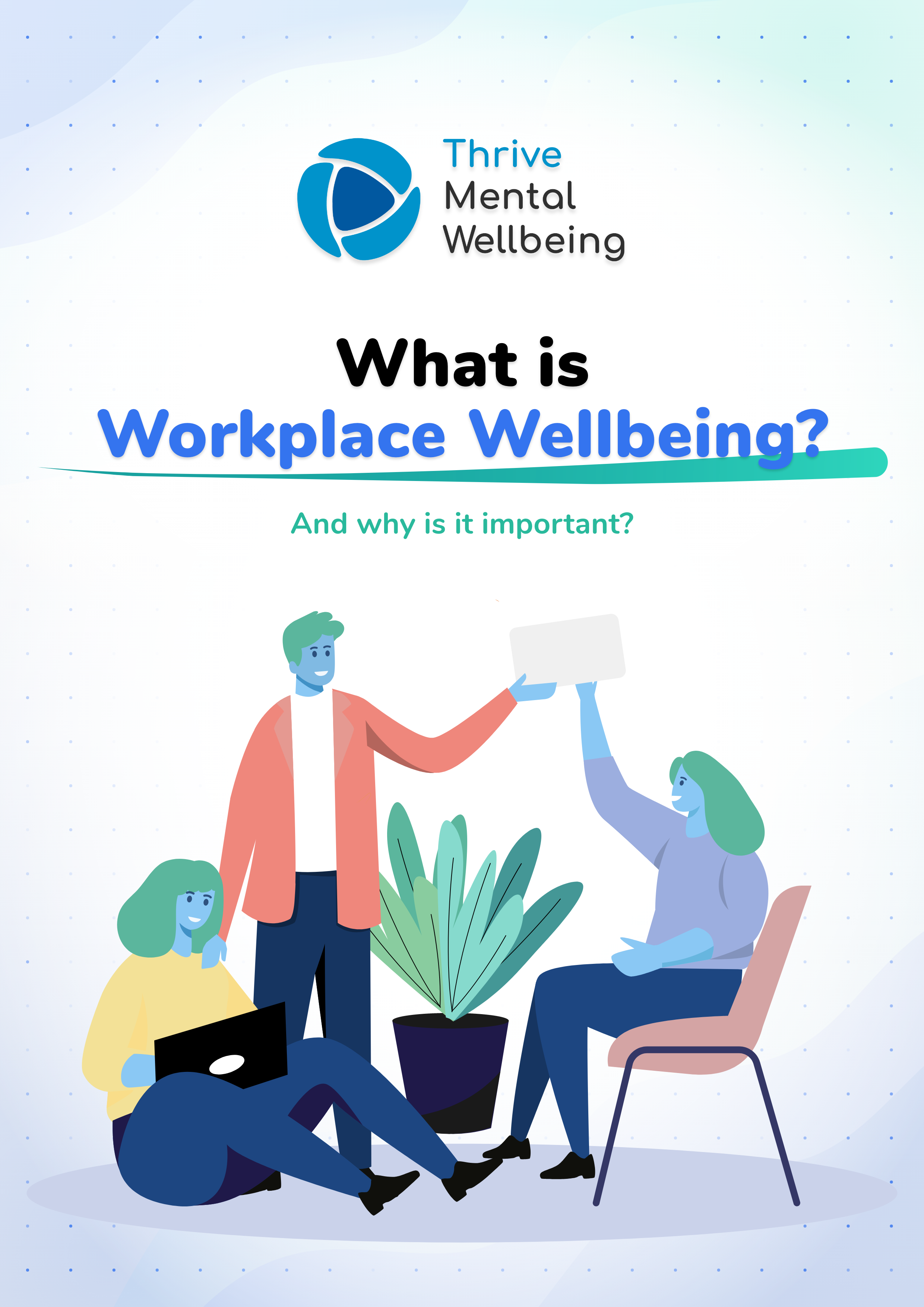
June 3, 2024
What Is Workplace Wellbeing and Why Is It Important?
The concept of workplace wellbeing has attracted an increasing amount of attention in recent years, as organisations recognise the critical role it plays in business success.

Workplace wellbeing is best defined as a holistic approach that supports the mental, emotional, and physical health needs of employees in the workplace.
Businesses that prioritise workplace wellbeing recognise that an employee's health is not only crucial for their personal life - but also plays a vital role in their productivity and engagement at work
In this article, we’re going to explore the concept of workplace wellbeing a little further, explaining why it’s important, and introducing some common tools and techniques to help you embrace the approach within your business.
Exploring workplace wellbeing: key components and benefits
Embracing workplace wellbeing involves a number of different components, including making sure your employees have supportive working conditions, that you consider their mental and emotional health, and promote physical wellbeing.
These components all work together to create a balanced and healthy work environment that benefits both your employees and your business.
It’s really important to recognise the interconnected nature of the different aspects of workplace wellbeing. For example, a physically healthy employee is more likely to have better mental health, and a mentally healthy employee is more likely to be productive and engaged at work.
The advantages of a wellbeing-focused workplace are significant.
When employees feel supported and cared for, they experience higher levels of job satisfaction and are more likely to be loyal to you as their employer.
This increased satisfaction can also translate into improvements in productivity, as employees are more motivated and engaged in their work.
Additionally, a focus on wellbeing can lead to reduced absenteeism, as employees are less likely to take time off due to stress, burnout, or illness.
Beyond the individual benefits for employees, a wellbeing-focused workplace contributes to a positive corporate culture.
When your business is seen to prioritise the health and happiness of your employees, it sends a strong message about your values. This can help you attract top talent, as job seekers increasingly look for employers that offer a supportive and healthy work environment.
Reimagining mental health: enhancing wellbeing in the workplace
Supporting employee mental health at work is an important component of workplace wellbeing.
There are a variety of different strategies and approaches that your business can take - but one of the most important foundations is to create a supportive environment where employees feel comfortable discussing their mental health concerns without fear of stigma or discrimination.
This doesn’t just have to be a reactive approach. To be fully supportive, it’s important that managers and supervisors across your business are trained to recognise signs of anxiety and stress and know how to engage with colleagues proactively.
Your business might also consider providing access to mental health resources, such as employee mental health support apps, counselling services, and stress management workshops.
For example, Thrive offers a comprehensive suite of clinically proven tools and resources to support employee mental health at work, including a mobile app with self-guided programs, online therapy sessions with licensed professionals, and expert-led workshops and training.
Another important aspect of reimagining mental health in the workplace, is to make sure your business encourages healthy behaviours and prioritises self care.
Every business is different, but some broad techniques might include:
- Regularly assessing and addressing workloads to prevent burnout
- Encouraging work-life balance and setting clear boundaries between work and personal time
- Providing opportunities for social connection and team building
- Offering flexible work arrangements to accommodate individual needs and preferences
- Investing in mental health training for managers and employees
Workplace wellbeing isn’t something you can ‘set and forget’ - It's important to continuously evaluate and modify your mental health policies to make sure they remain effective.
This might include regularly asking for feedback from employees about their work-life balance, and staying informed about the latest research and best practices.
Identifying, confronting, and overcoming mental health discrimination at work
As part of reimagining mental health in the workplace, it goes without saying that you should implement all the necessary processes and policies to eradicate any form of mental health discrimination within your business.
Despite 1 in 4 of us being likely to suffer from mental health issues, there’s still a stigma attached to talking about mental health challenges. It's important to create a safe, open environment where employees feel comfortable seeking support without fear of judgement or discrimination.
Not only is this the right thing to do for your employees, it’s also crucial to protect your business from legal consequences.
Under the Equality Act 2010, mental health conditions that have a substantial and long-term effect on a person's ability to carry out normal day-to-day activities are considered disabilities. This means that employees with mental health conditions are protected from discrimination, harassment, and victimisation in the workplace.
There are four main categories of mental health discrimination to be aware of and address:
Direct discrimination
This occurs when an employee is treated less favourably than others because of their mental health. For example, if an employee is denied a promotion due to their mental health condition, this would be considered direct discrimination.
Indirect discrimination
This is less obvious, but occurs when a workplace policy or procedure puts employees with mental health conditions at a disadvantage compared to others.
For example, if a company has a policy that all employees must work night shifts, this could indirectly discriminate against those with mental health conditions that are sensitive to disrupted routines.
Harassment
Harassment refers to any conduct in the workplace that relates to a person's mental health condition that creates an intimidating, hostile, degrading, humiliating, or offensive environment. This can include insensitive jokes, bullying, or intrusive questions about an employee's mental health at work.
Victimisation
This is where an employee is treated unfairly because they have made or supported a complaint about mental health discrimination. For example, if an employee is denied opportunities or subjected to bullying after filing a complaint about harassment related to their mental health.
To make sure you’re taking all necessary steps to eradicate mental health discrimination, it’s important to take proactive steps, which might include:
- Developing and enforcing anti-discrimination policies that cover mental health conditions
- Training managers and employees on mental health awareness and how to prevent discrimination.
- Encouraging open communication about mental health at work and providing support resources.
- Investigating and addressing any reports of discriminatory behaviour promptly and fairly.
- Making reasonable adjustments to support employees with mental health conditions.
Effective strategies for implementing workplace wellbeing
We’ve already discussed the important strategies and approaches you can take to help support mental health in the workplace as part of your workplace wellbeing strategy.
But workplace wellbeing is more than just focusing on mental wellness - it also involves focusing on supportive working practices designed to encourage a healthy work-life balance for employees, and also promoting the importance of physical health.
When it comes to work-life balance it’s important that your office culture doesn’t inadvertently glorify overworking, or responding to messages and emails outside of working hours. You might also consider offering flexible working arrangements for employees, allowing them to adjust their working hours around their personal commitments.
Physical health initiatives might include offering gym memberships or on-site fitness facilities, providing healthy food options in the vending machines or cafeteria, and encouraging regular breaks and physical activities throughout the day.
By promoting work-life balance and physical health alongside mental health strategies, your business can have a more holistic approach to workplace wellbeing.
Whatever approach you decide to take towards workplace wellbeing, it’s important to recognise that it needs to be supported from the very top of your organisation.
Some of the common elements of successful workplace wellbeing programs include:
- Leadership commitment and support
- Clear communication and employee engagement
- A range of resources and support options
- Regular evaluation and improvement
- Integration with overall company culture and values
Progress checks: measuring success and evaluating wellbeing initiatives
Implementing workplace wellbeing strategies is an all important first step, but it's equally crucial to measure the success and effectiveness of these initiatives over time.
Regular progress checks and evaluations help your business understand what's working, what needs improvement, and how to adjust your approach to better support employee wellbeing.
When assessing the effectiveness of wellbeing initiatives, it's important to use a combination of different measures and metrics, such as:
- Employee engagement and satisfaction levels
- Usage of mental health resources and support services
- Absenteeism rates
- Productivity and performance metrics
- Employee retention and turnover rates
Conducting regular employee surveys and feedback sessions can provide valuable insights into how employees perceive and engage with your workplace wellbeing initiatives.
It's also important to track progress over time and compare metrics before and after implementing wellbeing initiatives. This can help illustrate the impact that your approach is having, and help ensure your programme receives ongoing funding and support.
The business impact: workplace wellbeing and organisational success
Investing in workplace wellbeing is not only beneficial for employees but also has a significant impact on business performance.
When employees are healthy, happy, and supported, they are more likely to be engaged, productive, and committed to their work.
Research has consistently shown the link between employee wellbeing and various business outcomes. For example, a study by the University of Warwick found that happy employees are 12% more productive than unhappy employees. Similarly, a report by Deloitte found that organisations with effective mental health and wellbeing programs see an average return on investment (ROI) of £5 for every £1 spent.
Workplace wellbeing initiatives can also have a significant impact on employee retention and recruitment. In today's competitive job market, job seekers increasingly prioritise companies that offer comprehensive wellbeing programs and support. By investing in employee wellbeing, your business can attract and retain top talent.
The business case for workplace wellbeing is clear - it's not just a "nice to have" but a strategic driver for business success.
Case studies: transforming office culture through wellbeing
To help illustrate the power of workplace wellbeing initiatives, it's helpful to look at real-world examples of businesses that have successfully integrated these strategies into their work cultures.
One example is Dishoom, a British restaurant chain that has an impressive approach to employee wellbeing. They fully train managers in mental health first aid, and provide a 24-hour counselling helpline. Additionally, they offer discounted memberships to local gyms and yoga studios to improve employee’s physical health.
Another good case study is AND Digital, a digital agency that works with some of the UK's biggest brands. They provide mental health at work training, an employee assistance program, mindfulness sessions, and dedicated mental health support services.
Allplants, a vegan food delivery service, is another company with workplace wellness as a priority. They offer a hybrid working model to support flexibility, a £500 yearly learning allowance, a cycle to work scheme, parental leave, and pregnancy loss support leave.
At Thrive, we've recently worked with an international high street bank who were facing challenges including high levels of employee burnout and high levels of absenteeism. There was also a culture of stigma about employees sharing their mental health issues due to a fear of being treated differently or having it impact their career progression.
By implementing Thrive Mental Wellbeing, the bank was able to provide employees with tools to help them manage the day-to-day challenges of their roles, and build up their mental resilience.
Thrive also enabled bank employees to access confidential 1-1 therapy sessions where they could talk in confidence about any mental health issues they were facing. With more than 1000 therapy sessions delivered over a 12-month period, it's estimated the bank saved £1.43m by reducing sickness related absences and reducing staff turnover.
Leading change: a guide to initiating workplace wellbeing for HR leaders and executives
HR departments play an important role in shaping office culture and promoting employee wellbeing.
Initiating a workplace wellbeing programme may seem daunting, but with the right approach and support from the correct tools - it’s easily achievable.
To start with, it’s important to make sure you have buy-in from key stakeholders, including senior management. To help achieve this, consider presenting a compelling business case that highlights the benefits of investing in employee wellbeing, such as increased productivity, reduced absenteeism, and improved retention rates.
Once you have secured buy-in, the next step is to conduct a workplace wellbeing assessment that identifies how your business is currently performing. From this, you can develop a clear and comprehensive wellbeing strategy that addresses any issues, and aligns with your organisation's values and goals.
When implementing your wellbeing programme, consider partnering with experienced providers like Thrive, who can offer tailored solutions and expert guidance.
Thrive's comprehensive suite of clinically proven mental health tools, including our mobile app, online therapy sessions, and workshops, can help you create an effective workplace wellbeing programme that supports your employees' mental and emotional health.
Once you’ve implemented your workplace wellbeing initiatives, it's recommended to regularly request feedback from your employees, so you can gain a better understanding of what’s working well and what is not - so you can adapt based on these insights.
Connect with Thrive: drive your workplace wellbeing strategy to new heights
At Thrive, we understand the challenges that organisations face when it comes to implementing effective workplace wellbeing programs.
That's why we're here to support you every step of the way.
Our comprehensive suite of mental health tools and services includes a user-friendly mobile app that offers evidence-based tools and techniques to help employees manage stress, build resilience, and improve their mental health.
We connect employees with licensed therapists for confidential, one-on-one sessions via video, phone, or chat. Our therapists specialise in a range of areas, including stress management, anxiety, depression, and work-related issues.
We’re also able to deliver engaging and informative workshops on topics such as mental health awareness, resilience, and leadership development.
By partnering with Thrive, you can benefit from our expertise, innovation, and commitment to driving positive change to wellbeing in your workplace.
To learn more about how Thrive can support your workplace wellbeing strategy, contact our team today.
Topics mentioned in this blog post:
Get the latest news with
Thrive Unplugged!
Sign up to our monthly newsletter to receive the latest news on everything Thrive Mental Wellbeing.








